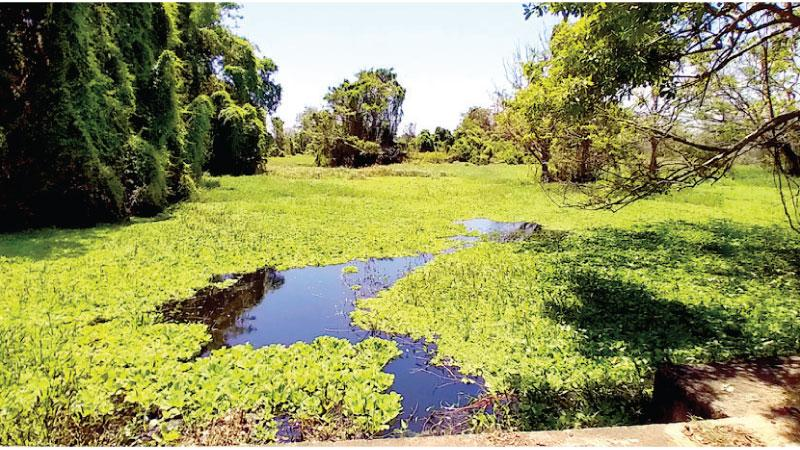The Anawilundawa Wetland Sanctuary also known as Anawilundawa Bird Sanctuary is in the Arachchikattuwa Divisional Secretariat division in the Puttalam District and covers 1,397 hectares.
This wetland which comprises seven tanks built close to the ocean is bordered by the Battuluoya and the Udappuwa main road in the North, the Chilaw – Puttalam railway in the East, the Sengal Oya in the South and the Paru Cannal (Holand Cannal ) in the West. The Ratambala Oya is the main water source of the Wetland. The Wetland is also fed by floodwaters of the Deduru Oya brought to the area via the Sengal Oya scheme.

This wetland sanctuary comprises seven manmade shallow tanks: Pinkattiya tank (40 hectares), Wellawali tank (currently not holding water ), Maradansola tank (12 hectares), Irakkawela tank (14 hectares ), Anawilundawa tank (40 hectares),Surawila tank (32 hectares) and Mahayiyava tank (50 hectares ). According to historical records, they were built in the 12th century during the reign of King Parakramabahu 1. These tanks are interconnected and form one wetland with a complex irrigation system.
Anawilundawa is a unique area of land close to three vastly different ecosystems; the coast, the mangroves and the fresh water tanks. It is this rarity that is the reason for the reputation of the wetland as being one of the six Ramsar wetlands in Sri Lanka.
Ramsar wetland
The World Conservation Union conducted a study on the biodiversity of the wetland and on August 3, 2001, it was declared an international Ramsar wetland. A Ramsar site is a wetland site designated to be of international importance under the criteria of the Ramsar Convention on wetlands signed at the Iranian town of Ramsar in 1971. Four years before it was declared a Ramsar wetland, on June 11, 1997, the Anawilundawa Wetland had been declared a sanctuary by the Department of Wildlife Conservation.
The tank system of the Anawilundawa Wetland helps feed traditional paddy fields in the area as well as islets of natural vegetation. About 412 hectares of paddy fields are said to be asweddumised with the water of these tanks.
This Ramsar wetland is rich in fauna and flora and therefore, has become a natural habitat for more than 150 species of aquatic birds, 20 species of mammals, 70 species of butterflies and over 50 percent of Sri Lanka’s freshwater fish species.
There are different categories of bids in Anawilundawa such as wetland birds (waders, gulls and terns, ducks, herons, egrets and storks, great cormorants, kingfishers, the purple swamp hens), forest birds (woodpeckers, barbets, pigeons, raptors), scrubland birds (bulbuls, doves) and grassland birds (munias, prinias, pipits, larks and raptors). Migratory birds such as sandpipers, stints, plovers, terns and gulls share the wetland with its resident birds such as herons, egrets, pelicans, great cormorants and storks. The period from October to April is tailor-made for visiting the sanctuary to spot these migratory birds since they arrive in October and leave by April every year.
The Anawilundawa sanctuary is also home to 20 species of mammals. Among them are toque monkeys, slender oris, rusty spotted cat, the otter, rats, mice, shrews, bats, black-naped hare, mouse deer, fishing cat, mongoose, and jackal. Small herds of wild elephants are roaming the sanctuary especially during the dry season. Slender lorises dominates the trees in the sanctuary.
The reptilian fauna of the wetland comprise the flap shell turtle, the star tortoise, milk tortoise, stone tortoise, crocodiles, lizards, skinks and geckos, green vine snake and many other reptiles. The cobra, Russell’s viper and the common Indian Krait known as three highly venomous serpent species also inhabit the sanctuary.
Over 264 plant species belonging to 86 families also add colour to and enrich this biodiversity hotspot. Some 218 plant species are native while Pupulu Vernonia Zeylanica is endemic to Sri Lanka. There are also invasive alien plant species. Most of the plant species found in the sanctuary are used in traditional medicine. Huge, tall trees, woody plant species, shrub species, herbaceous plant species, aquatic plants, two special species of epiphytes and many other species of climbers make this an eye-catching landscape of thick lush green vegetation.
The tanks within the sanctuary play a multidimensional role in the ecosystem. They control flood, recharge aquifers, retain pollutants and sediments and provide the ecosystem with the indispensable, i.e. water for its survival. Sustainable traditional farming and inland fishing wouldn’t be possible if it were not for this system of tanks.
Unscrupulous element
Despite the inexpressible significance of safeguarding this unique ecosystem, some unscrupulous, ignorant people harm this natural treasure land which has great potential to become more popular as an ecotourism site. But extension of prawn farms or prawn hatcheries in surrounding areas has led to mangrove destruction and pollution whereas the other potential threat comes from the excessive use of fertiliser and pesticides in coconut plantations in the vicinity of the wetland.
Although the area of the Anawilundawa sanctuary which is about 95 km away from Colombo belongs to the dry zone of the North Western Province, this land and air of pools of water, tanks, thickets, bushes, and forests teeming with giant trees and vines comfort whoever frequents there with coolness in a wet zone. The tranquility of the environment is disturbed only by the beautiful chirping of lovely birds of different kinds and the sweeping sound of the gentle breeze blowing from all directions kissing the trees and vines and lake water.
Intoxicated by the splendour of the wonderful, picturesque, enchanting nature there, bird-watching enthusiasts, nature lovers, environmentalists, and citizen naturalists would be reluctant to return from this unique wetland of spellbinding beauty. Let there be everlasting protection for this open natural art gallery, which is no doubt a potential tourist attraction.
